

Design Patterns in Ruby: Abstract FactoryDevInterface Blog. Design Patterns in Ruby - Russ Olsen. Design Patterns in Ruby: Observer, Singleton. I am going to be posting a few articles related to Software Design Patterns and how they are applicable to Ruby.

The first two patterns that will be covered are the Observer Pattern and the Singleton Pattern. Observer Pattern If you are not familiar with this pattern, no worries, it is basically a mechanism for one object to inform other ‘interested’ objects when its state changes. To be a little more descriptive, here is a direct quote from Wikipedia: The observer pattern (aka. The Observable module in the Ruby standard library provides the mechanism necessary for us to implement this pattern, and it is fairly easy to use. The Planning. Ruby Singleton Pattern. Singleton is perhaps the most hated of all programming patterns.
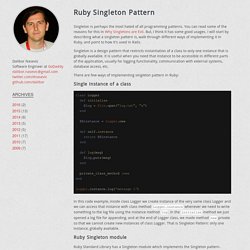
You can read some of the reasons for this in Why Singletons are Evil. But, I think it has some good usages. I will start by describing what a singleton pattern is, walk through different ways of implementing it in Ruby, and point to how it's used in Rails. Singleton is a design pattern that restricts instantiation of a class to only one instance that is globally available. It is useful when you need that instance to be accessible in different parts of the application, usually for logging functionality, communication with external systems, database access, etc.
Classes, Objects, and Variables @ Programming Ruby. From the examples we've shown so far, you might be wondering about our earlier assertion that Ruby is an object-oriented language.
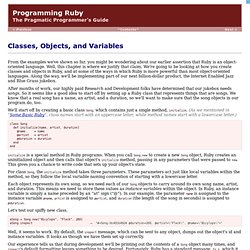
Well, this chapter is where we justify that claim. We're going to be looking at how you create classes and objects in Ruby, and at some of the ways in which Ruby is more powerful than most object-oriented languages. Along the way, we'll be implementing part of our next billion-dollar product, the Internet Enabled Jazz and Blue Grass jukebox. After months of work, our highly paid Research and Development folks have determined that our jukebox needs songs. So it seems like a good idea to start off by setting up a Ruby class that represents things that are songs. We'll start off by creating a basic class Song, which contains just a single method, initialize. class Song def initialize(name, artist, duration) @name = name @artist = artist @duration = duration end end.
Implementing and Testing the Singleton Pattern in Ruby. What is a Singleton Object?
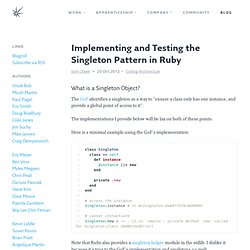
The GoF identifies a singleton as a way to "ensure a class only has one instance, and provide a global point of access to it". The implementations I provide below will be lax on both of these points. Here is a minimal example using the GoF's implementation: 1 class Singleton 2 class << self 3 def instance 4 @instance ||= new 5 end 6 7 private :new 8 end 9 end10 11 # access the instance12 Singleton.instance # => #<Singleton:0x007fd70c889880>13 14 # cannot instantiate15 Singleton.new # ~> -:12:in `<main>': private method `new' called for Singleton:Class (NoMethodError) Note that Ruby also provides a singleton helper module in the stdlib. Singletons == meh It sounds like a great idea: you have one logger, and everything logs through it. You will experience difficulty testing these because if they retain state (e.g. a logger with a file_name) then you will need to figure out how to reset that state between tests.
What to do about it? 1. 2. 3. Issue 2.8: Ruby and the singleton pattern don't get along - Practicing Ruby. Many design patterns that originated in other object-oriented languages have elegant Ruby translations.
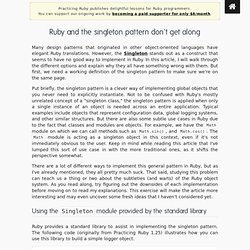
However, the Singleton stands out as a construct that seems to have no good way to implement in Ruby. In this article, I will walk through the different options and explain why they all have something wrong with them. But first, we need a working definition of the singleton pattern to make sure we're on the same page. Put briefly, the singleton pattern is a clever way of implementing global objects that you never need to explicitly instantiate. Ruby Best Practices- Issue 1.25: Creational Design Patterns. Originally published as part of the first volume of the Practicing Ruby newsletter on February 22, 2011.
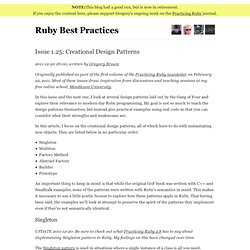
Most of these issues draw inspiration from discussions and teaching sessions at my free online school, Mendicant University. In this issue and the next one, I look at several design patterns laid out by the Gang of Four and explore their relevance to modern day Ruby programming. My goal is not so much to teach the design patterns themselves, but instead give practical examples using real code so that you can consider what their strengths and weaknesses are. In this article, I focus on the creational design patterns, all of which have to do with instantiating new objects.
They are listed below in no particular order: Singleton Multiton Factory Method Abstract Factory Builder Prototype An important thing to keep in mind is that while the original GoF book was written with C++ and Smalltalk examples, none of the patterns were written with Ruby’s semantics in mind.